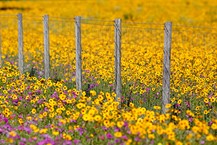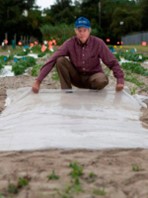Planting Wildflowers
A Florida native wildflower is a flowering herbaceous species that had grown wild in the state’s natural ecosystems in the 1560s when Florida’s first botanical records were created. Planting native wildflowers in Florida benefits natural resources, native pollinators, and other beneficial insects. By planting wildflowers, one is providing shelter for pollinators and increasing wild be & natural enemies of insect pests population. When protecting, enhancing, or restoring habitat to benefit pollinators, choose a mix of native plant species that will bloom throughout the year and provide a continuous source of pollen and nectar for many pollinator species. Site planting and preparation are crucial to establishing new pollinator habitats. The site should be manageable, benefit wildlife, and support the overall management practices of the property.

Wildflower selection
Diversify your selection of seeds. Flowering species native to Florida and suited to specific site conditions are the best choice for attracting and supporting diverse pollinator populations. Try to use seeds that are not native and are produced in Florida. Florida-produced seeds will be better adapted to Florida’s growing conditions. Planting a mixed species that bloom at different times will benefit pollinators throughout the year. Different flower sizes, shapes, colors, and plant heights will attract more pollinators and other insects.
Site Planning & Preparation
Wildflower plots that are planted in full sun provide the most pollen and nectar and are more attractive to pollinators. Bees can start working on flowers early in the day. However, flowers wet with dew may be ignored until they are dry. Plant along field edges on farms, cleared from pesticide drift and areas that will not disturb farming practices. Wildflowers should be planted in areas where the ground is not disturbed regularly. Most bee species do not live in communal colonies or collaborate in rearing offspring; 70% of these solitary bees nest in the ground. Plant in multiple locations that have well-drained. An available water source for irrigation benefits the planting, mainly during seed germination and early seedling establishment. Once plants have been established, additional watering is usually only necessary in drought.
Proper site preparation is needed to minimize weeds throughout plot establishment and growth. At least an entire season of weed eradication before planting is necessary. At least two months before planting, mow the area and remove any thatch. Allow new weed growth to begin, and then treat the site with a non-persistent, post-emergent herbicide. Repeat the herbicide treatment at least twice, two weeks between applications, allowing for more weed growth between treatments. This process can start as soon as weeds grow in early spring. Some herbicides have a residual activity that can kill or prevent the germination of wildflower species typically included in pollinator planting. Herbicide labels list species that are tolerant depending on the rate applied. It is crucial always to follow label instructions. As organic weed management, sites can be prepared using solarization. This technique uses greenhouse plastic to raise high soil temperatures to kill weedy plants and seeds in the top four to six inches of soil. Solarization can be done using large sheets of plastic to control weeds. After either solarization or chemical treatment and mowing, the aim is to have at least 90% of the soil free of plant material to ensure proper seed-to-soil contact during planting.

Seed the plot
Depending on the region, plots should be planted between September and January in Florida after an entire season of site preparation. No-till planting is recommended. Years of weed seeds are stored within the soil, waiting to be exposed to sunlight and begin germinating. Tilling an area will disturb the seed bank and promote weed growth rather than wildflower growth. When the plot is ready, mix seeds based on size and weight. Annual and perennial seeds can be mixed and planted together. Alternatively, annuals and perennials can be planted in separate blocks to allow each type to be managed individually. Multiple techniques and equipment are used to spread seeds along the soil surface. Using tractor-pulled equipment is the most efficient option for larger plots but is less successful in evenly spreading lightweight seeds. Be cautious of using a too-heavy roller in very sandy soil. Excessive weight will force the seeds too far under the sand, where they will not germinate. A no-till seed drill is an alternative to spreading seed on the plot surface. Equipment costs of renting or purchasing a seed drill can be expensive for small wildflower plots; however, seed drills can be very efficient for larger wildflower establishments.
Crop Management
Undesirable weeds may establish quickly within the wildflower plot in the first year, especially if the site is not thoroughly prepared. Monitor the plants and try to control weeds sooner rather than later. Fertilization generally is not necessary. If competing weedy grasses start establishing in the plot, use a grass-specific herbicide to achieve control as quickly as possible, preferably while the grass weeds are small. However, if you have included native grasses in your planting, consider using a mechanical control method. The herbicide used will depend on the species you are trying to control. Spray using a coarse/large droplet size to avoid overspray onto desired species. Whenever possible, spray at night to prevent times when pollinating species will be present on the flowers. Always follow the product label when applying herbicides of any type. Hand-pull small patches of competing weeds. Cut or use a weed trimmer on larger patches of weeds. Mowing your planting can reduce weed competition. In perennial-only plots, mow throughout the first year to inhibit the growth of annual weeds. Mow plots were planted with annual and perennial wildflowers in the late fall of the first year after planting. Mow at a low enough level to hit and distribute the seed heads but high enough to avoid disturbing the bases of overwintering perennial plants. The actual timing of this mowing will depend on region, soil type, and weather.
For more detailed information:
PlantGuide.pdf (flawildflowers.org)
- Native fruit trees- The Common Persimmon - September 22, 2023
- We Are HOT!! So Are Our Ecosystems: The Effects of Increasing Climate Change on Agriculture and Natural Resources - July 14, 2023
- Wildflowers 101 - March 3, 2023
